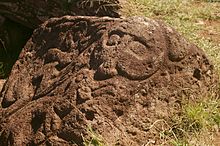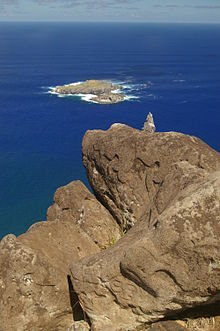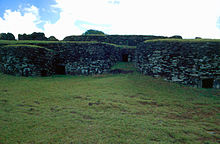Orongo (Easter Island)
Coordinates: 27 ° 11 ′ S , 109 ° 27 ′ W
Location of Orongo |
Orongo is an important place of worship on Easter Island . It is closely related to the Vogelmann cult and is unique in terms of its location, size and design in the entire Pacific .
Rongo is - with all the variations in the various Polynesian dialects - the name of a deity who is specifically associated with chants, with speaking, or with speaking and listening. Dance and music groups as well as all objects that emit sounds or noises are linked to the cult of Rongo, in Mangaia for example the conch trumpet. His incarnation is the rainbow and his voice can be heard in the thunder. He is the god of agricultural products, especially the sweet potato. It cannot be ruled out that during the centuries of isolation on Easter Island, Rongo transformed into Makemake, who was particularly venerated at the Orongo cult site. Rongo also means noise, tone, sound and is also used in the sense of song, spoken song, recitation. Orongo could be translated freely: the place where chants are performed.
location
The exposed location of the cult site already indicates the ritual significance of the place. Orongo is located on a narrow cliff on the southwest tip of Easter Island. On one side the steep wall drops 300 meters to the sea, on the other side 200 meters to the crater lake of the volcanic crater Rano Kao . From here there is an overwhelming view of the Pacific Ocean with the three motus off Easter Island , which were of particular importance in the context of the cult activities.
description
When entering the complex, the stone slab houses and the numerous petroglyphs immediately catch the eye. The other relics - observatory, ahus, paenga houses, round houses - which are predominantly in the peripheral areas or immediately outside the complex, can no longer be easily identified.
Houses
There are 52 well-preserved stone houses in Orongo. They are built from flat natural stone slabs that are anchored in the ground and layered on top of each other without mortar . The outer walls are double-skinned, with a filling of earth and rubble in between. The windowless houses have an elongated oval floor plan with just one tunnel-like, approx. 50 cm high entrance and can therefore only be entered by crawling. Notwithstanding, two houses are designed as circular buildings, but otherwise of the same construction.
Inside there is usually only one room, rarely two or a small extension. The rear inner wall consists partly of large, vertical stone slabs that were originally painted in colors (red-brown, black and white). The German South Sea expedition found the paintings in good condition in 1882. Subsequent visitors removed several panels and forcibly broke open some houses. The remaining ones have recently been removed for conservation reasons and are now in the Hangaroa Museum. In 1952, the Thor Heyerdahl expedition identified a total of 11 motifs: depictions of ships , an ao dance paddle , a face (the creator god Makemake ?), Vulva and bird men.
Towards the roof, the bricks of the houses push themselves more and more inwards, so that a cantilever vault is created that is covered with larger panels and insulated with earth and turf . In front of some entrances, stone-paved earth ovens (according to dissenting opinion, they are storage pits) were found.
The length of the house interiors varies between 6 and 16 meters, the width averages 2.50 m, the height about 1.40 m. The smallest interior space of a house was measured with 2.0 m² and the largest with 27.7 m².
Various expeditions carried out excavations in the interior. Objects of daily use were found: bone needles, tattoo tools , obsidian blades , animal bones. In several houses Thomson and Routledge discovered so-called "stone pillows " ( ngaru´a ), which were decorated with numerous vulva motifs. Their use and meaning are unknown.
In the center of the complex there is a kind of paved courtyard, which is surrounded in a semicircle by several houses, some of whose entrances are right next to each other. The report of the American Easter Island expedition of the USS Mohican of 1886 contains a photo of a group of houses with four entrances and a statue as a center post (house R-42). There were other decorated or sculpted frames , but these were removed and are now in collections in Europe and America.
Inside a large house (house R-13), the ship's doctor Palmer discovered a moai from the British ship Topaz in 1868 , the only one in Orongo. The 2.40 m tall, 4 tonne basalt statue with the name Hoa-haka-nana-ia was stuck in the ground up to its navel and was painted red and white (today there are only small remains of paint). The back of the sculpture is covered with reliefs of bird men, ao (dance paddles) and vulvae. The German ethnologist Heide-Margaret Esen-Baur considers it the main shrine of the Vogelmann cult on Easter Island. Thor Heyerdahl believes that the figure served as the prototype of all moais of the classical period. It is now in the British Museum in London .
Petroglyphs

The entire area is covered with numerous rock carvings (petroglyphs) of various sizes. The Franco-Belgian expedition of 1934/35 listed 53 boulders with a total of over 200 images. The motifs keep recurring. In order of frequency they are:
- Vogelmann, a zoomorphic mixture of humans and frigate birds
- Bird (possibly a tern )
- Face or mask (probably the creator god Makemake )
- vulva
- ship
- Ao dance paddle
as well as some marine animals (fish, whale, seal (?), turtle) and unspecified graphic motifs in the vicinity of the entrance to the facility. In terms of quantity, the bird man representations predominate. The quality of the petroglyphs varies, both reliefs of the highest artistic perfection and simple, clumsy-looking incised drawings have been preserved. The distribution does not follow a comprehensible system. The purpose of the depictions in the context of cult acts can no longer be understood today. It is believed that the tribes that provided the respective bird man "perpetuated" here.
Ahu
In the northeast of the facility, the Heyerdahl expedition exposed the remains of two ahu (ceremonial platforms). They are platforms built up roughly from largely unworked stones without stone figures. Today they are only recognizable as unordered collections of stones. As a rule, Ahu are in close spatial connection with residential complexes.
In 1974, the American anthropologist William Mulloy excavated the foundation walls of a paenga house (home of the elite). Patrick C. McCoy, anthropologist at the Bernice P. Bishop Museum , proved that there were other Paenga houses as well as the foundations of stone round houses and brick earth ovens as early as 1961.
These finds show that Orongo was not exclusively of ritual significance, but was closely connected to permanently inhabited settlements. This is supported by evidence of agricultural cultivation terraces on the inner slopes of the Rano Kau crater.
observatory
The archaeologist Edwin Ferdon put 1952 in an outlying area of the plant one (today hardly be recognized) free stone setting, which he called " Observatory identified". He discovered worked stones with drilled holes and found out that the position of the sun at the summer and winter solstices and the equinox could be determined with inserted shadow sticks . In addition, numerous petroglyphs and the small stone statue of a disembodied head were found in the vicinity.
Cultic meaning
Orongo must be seen in close connection with the Vogelmannkult, but was also related to fertility rites , as the frequent vulva depictions suggest. The place of worship also served to worship the god Makemake , who, according to Polynesian tradition, was the creator of the world and lord of the birds.
According to some ethnologists, the Vogelmann cult is the central cult on Easter Island. Obviously, however, it is not limited to Easter Island, birdman representations are u. a. also known from Samoa , the Sepik region in New Guinea and from some South American cultures.
The bird man rites on Easter Island have been handed down orally, but differ in the details in the absence of written records. The following short version follows the presentation of the ethnologist Alfred Métraux :
In July of each year, the tribes from the village of Mataveri went in procession to Orongo. This was the time when the terns laid their eggs on the offshore motus. The war chiefs of the tribes held a contest to see who would succeed in bringing the sooty tern's first egg ( Sterna fuscata ) ashore. They did not enter the competition personally, but were represented by subordinates, the hopu . They climbed down the steep cliffs and swam with the help of bundles of reeds, on which they carried some supplies, to the Motu Nui , a highly dangerous undertaking because of the steep coast, the strong surf and the sharks . There they waited in caves for the terns to breed. The stay, which sometimes lasted several weeks, ended as soon as a hopu discovered a tern egg . He put the egg in a piece of tapa , tied it around his head, and started the dangerous way back. He presented the egg to his chief, who from then on bore the title of bird man ( tangata manu ). He shaved all his body hair, painted himself with red and black stripes and went in a procession - according to the descriptions, in a trance - to Mataveri. There was a festival there that lasted several days, which, according to tradition, also resulted in sexual and cannibalic excesses.
The bird man was surrounded by special holiness in the months that followed. He enjoyed great power, he was said to have magic powers, but he also lived in particular seclusion and had to submit to numerous restrictions, for example he was not allowed to touch food with his hand. Despite some disadvantages, the title of bird man was very popular and associated with high political and religious prestige.
In his feature film Rapa Nui, Kevin Costner shows the cult activities in Orongo very vividly, if not always historically accurate.
Age and intended use
Several archaeologists have since had dating done using different methods. They cover the period from 800 AD (earliest time) to 1810 (latest time). The vast majority of the dates, however, are in the 15th and 16th centuries AD, so that it can be assumed that the heyday of the cult site was during this period.
For a long time it was assumed that the Vogelmannkult later replaced the veneration of the ancestors , which manifested itself in the erection of the colossal statues of Easter Island. According to the dating, this view is no longer tenable, but it must be assumed that the two cults will exist in parallel - at least temporarily.
Recent archaeological research suggests that the giant stone statues (moais), the Orongo petroglyphs, and the Rongorongo tablets can be traced back to the same population. Older views that postulated the existence of two different cultures ("long-eared" and "short-eared" according to Thor Heyerdahl) on Easter Island should no longer be relevant.
Discovery and Exploration
Although Easter Island was discovered for Europe by Jakob Roggeveen as early as 1722 , the first European to enter the place of worship was probably Father Eugène Eyraud, who stayed on Easter Island as a missionary for nine months in 1864 and later from 1866 to 1868 . He left no description himself. However, his successors Roussel and Zumbohm reported extensively on the Vogelmann cult in letters to their superiors. According to their description, the last Vogelmann ceremony took place in 1862. From this point on, Orongo was no longer used ritually and was exposed to decay.
In 1868 the English ship Topaz visited Easter Island. The team removed the Moai Hoa-haka-nana-ia from one of the stone houses and took it to England .
From September 20 to 25, 1882, the German gunboat SMS Hyäne visited Easter Island during an extensive expedition to the South Sea. Captain Geiseler had received the order from the Imperial Admiralty to carry out scientific research for the ethnological department of the royal Prussian museums in Berlin . As part of this expedition, the first systematic investigations of the Orongo cult site were carried out, with detailed descriptions, find sketches and an overview plan.
The first photographs of Orongo as well as a further map and a detailed description were made by the purser William Thomson, who visited Easter Island from December 18 to 31, 1886 on board the American ship Mohican . He removed some petroglyphs now owned by the Smithsonian Institution in Washington DC .
The British Katherine Routledge first carried out research on a scientific basis in 1914/15. Although she was not a trained archaeologist, she had the support of the British Museum and the Universities of Oxford and Cambridge . Routledge prepared a detailed site plan and an exact description of all houses. She also presented a description and interpretation of the Vogelmann rites, which was based on an evaluation of the oral traditions of the inhabitants.
The aim of the Franco-Belgian expedition in 1934/35 with the ethnologist Alfred Métraux and the archaeologist Henri Lavachery was the investigation of Orongo. Lavachery presented a complete catalog of the Orongo petroglyphs, while Métraux undertook a comprehensive (re) interpretation of the Vogelmann cult.
The first modern archaeological investigations that u. a. also included stratigraphic excavations and radiocarbon dating , carried out by Edwin Ferdon as part of the Heyerdahl expedition 1955–56 and William Mulloy , 1974.
In 1983 the ethnologist Heide-Margaret Esen-Baur from the Johann Wolfgang Goethe University in Frankfurt am Main wrote a comprehensive standard work on the importance of the Orongo cult site.
Today's condition and tourist information
Orongo is an important destination for all Easter Island tourists. The place of worship is about 8 kilometers from Hangaroa. There is no paved road (yet), but the paths can also be used with non-off-road vehicles. A short walk is required from a parking lot. An entrance fee has to be paid at the parking lot. Since the excavation site is unsecured directly on a narrow cliff that slopes steeply to the sea, people who are afraid of heights can have problems in some places.
The painted stone tablets in the houses described by Geiseler have since been removed or weathered. Some are on display in the Hangaroa Museum. Otherwise the stone houses are in good condition, but the interior should not be entered. The petroglyphs on the stone blocks are directly accessible.
literature
- Kapitänleutnant Geiseler: The Easter Island, A place of prehistoric culture in the South Pacific . Berlin 1883.
- Thor Heyerdahl, Edwin Ferdon u. a., Reports of the Norwegian Archaeological Expedition to Easter Island and the East Pacific (Volume 1). London George Allen & Unwin Ltd., 1966.
- Thor Heyerdahl: The Art of Easter Island, Secrets and Riddles. Munich-Gütersloh-Vienna 1975. ISBN 3-570-00038-9 .
- Heide-Margaret Esen-Baur: Investigations into the Vogelmann cult on Easter Island. Frankfurt am Main 1983. ISBN 3-515-04062-5 .
- Heide-Margaret Esen-Baur: 1500 years of Easter Island culture - treasures from the land of Hotu Matua. Catalog for the exhibition in the Senckenberg Natural History Museum, Frankfurt a. M., April 5 to September 3, 1989. Mainz 1989. ISBN 3-8053-1079-X .
- Alfred Métraux: The Easter Island, Kohlhammer-Verlag Stuttgart 1958.
- Katherine Routledge: The Mystery of Easter Island. London 1919. ISBN 0-932813-48-8 .
- Henry Lavachery: Les Petroglyphes de L´Ille de Pâques. De Sikkel publishing house, Antwerp 1939.
- Patrick C. McCoy: The Place of Near-Shore Islets in Easter Island Prehistory. In: The Journal of the Polynesian Society , Vol. 87, No. 3 (September 1978), pp. 193-214.
Individual evidence
- ^ Jo Anne van Tilburg: Easter Island - Archeology, Ecology and Culture, London 1994, p. 127
- ^ A b c Edwin N. Ferdon, The Ceremonial Site of Orongo, in Reports of the Norwegian Archaeological Expedition to Easter Island and the East Pacific (Volume 1), London 1966.
- ↑ Kapitänleutnant Geiseler, Die Osterinsel - A place of prehistoric culture in the South Seas , Berlin, 1883, p. 15 ff.
- ^ Edwin Ferdon et al., Reports of the Norwegian Archaeological Expedition to Easter Island and East Pacific , Santa Fe 1961, p. 235.
- ↑ Heide-Margaret Esen-Baur, Studies on the Vogelmannkult on Easter Island , Wiesbaden 1983, p. 71.
- ↑ A beautiful, approx. 25 cm long example is in the Bernice P. Bishop Museum in Honolulu
- ^ Report by William Thomson 1886, http://www.rongorongo.org/thomson/447.html
- ↑ Esen-Baur, p. 151
- ^ Thor Heyerdahl, The Art of Easter Island, Munich, Gütersloh- Vienna, 1975, plate 5.
- ^ Henry Lavachery, Les Petroglyphes de L´Ille de Paques , Antwerp 1939.
- ↑ Patrick C. McCoy, Easter Island Settlement Patterns in the Late Prehistoric and Protohistoric Periods , Hanga Roa 1976.
- ^ Thor Heyerdahl, plate 2a
- ^ Alfred Métraux, Die Osterinsel, Stuttgart 1958, pp. 117 ff.
- ↑ Esen-Baur, pp. 219-220.
- ^ Thor Heyerdahl, Aku Aku, Berlin-Frankfurt-Vienna 1957.
- ↑ Esen-Baur, p. 287






